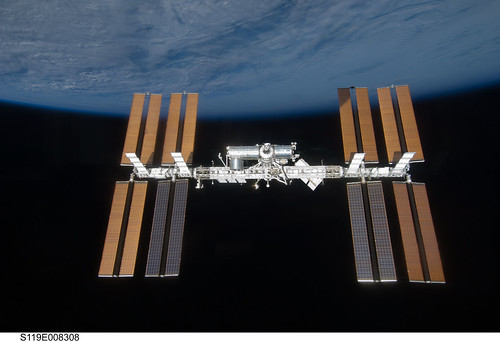…unless you’re 5 lucky astro/cosmonauts flying at 17,500MPH (almost 5 miles a second), over 200 miles above the surface of the Earth, looping the earth every 1 1/2 hours, up to 16 times per day, in that:
Yes, there are people in space 24/7 inside that, even now, as you read this. Maybe they’re passing over your hometown...
This, if you didn’t know, is the infamous International Space Station, or ISS, o ‘estación espacial internacional’, ‘EEI’, whatever the language you use.This high-quality picture was taken by the STS-119 crew at March 25 after undocking and doing the flyaround maneuver around the station, known as “TORF” (Twice Orbital Rate Flyaround), around 600 to 700 feet away, as they circled around it before doing an OMS separation burn to leave the vicinity of the station.
It’s called the International Space Station because it is a massive collaborative effort by different space agencies around the world, mainly USA’s NASA, Russia’s RKA, Canada’s CSA, Europe’s ESA, and Japan’s JAXA. The modules in the ISS were built by each of the international partners, and NASA and RKA launched the modules as they were built and tested, and put them together in orbit. The ISS should have been completed by now, but Columbia’s unfortunate and tragic accident on the last part of its last mission, STS-107, threw a wrench in the plans. However, the station is nearing completion steadily.
The station is pretty roomy now (it wasn’t before), and pretty lively. Since STS-119’s contribution to the station, there has been, at almost all times, a total of 6 people living and working inside the ISS, and the crew is considered collectively as an “Expedition”. So far there has been 22 expeditions to the ISS, or, 22 different crews. Russian Soyuz spacecraft take 3 people at a time to and from the station, and the astronauts and cosmonauts onboard can clock up to 6 months of stay at the ISS before being relieved by another crew and them returning on their Soyuz back to Earth. At most times, there are 2 Soyuz craft docked and a Soyuz lookalike called “Progress”, which is unmanned and is used for bringing supplies, food, air, etc to them. After they’re done with that Progress, they fill it with trash, and they let it go, and the craft burns up in the atmosphere, and Russia sends another one with more stuff, lather, rinse, repeat.
At this point in time, January 23, 2010, the station crewmembers, Expedition 22, comprised of Station Commander Jeff Williams (NASA), and Flight Engineers T.J. Creamer (NASA), Oleg Kotov (RKA), Maksim Surayev (RKA), and Soichi Noguchi (JAXA), are preparing and awaiting the arrival of Endeavour on its STS-130 mission. The STS-130 crew will deliver a major module (MORE SPACE!) to the ISS called Tranquility and a connecting node called “Cupola”, which is practically all windows, giving them an unobstructed view of both the Earth and the ISS exterior, making it an ideal place for robotic arm operations (and photo ops!).
However, I was going to talk about a feat Expedition 22 have achieved. After working solutions and setting up and testing, Expedition 22 have achieved what others couldn’t: to be able to directly (in a manner of speaking) access the internet from the ISS laptops while having KU Band connectivity (the high-speed data communications antenna link often used for live video feeds).
The method they used to be able to, say, post in Twitter, or send emails, is precisely that: emails. They directly sync their emails to Mission Control, and Mission control sends the emails as if it were them. In the case of Twitter, they send instructions in the form of an email to Mission Control, and Mission Control posts for them. Not really efficient but it got the job done. However, since we now have a “computer geek” astronaut on board, T.J. Creamer (MY HERO!), the guy did what I would have done if I had ever set foot there (nice feat considering you’re in free-fall microgravity)… actually work on direct internet access. And he got it!
Now, you’re probably saying “They have Macs up there right? or else the viruses will knock the station out of orbit!”. No, they don’t have Macs up there, they have laptops with Windows XP Professional (SP3?) loaded, with special software for controlling aspects of the ISS. While, yes, the danger of a virus knocking them out of orbit is plausible, I don’t think NASA would have left such a wide security hole in that. I have zero knowledge of the ISS’s control systems, so I can’t really say, but, hey, this is NASA we’re talking about.
However, additional layers of security aren’t bad. You can never have too much security! So, instead of actually having a DIRECT link to the internet, they access another computer down at NASA which has internet access through the ISS’s laptops… kinda like LogMeIn. (hopefully this computer comes with good antivirus software… I wonder, what did NASA pick for AV software and why?). This way, they can post on their own accounts, whenever they have time to do so, live. And of course, regular net browsing, email sending, the works. If the computer gets infected, the remote host (ISS laptop) is untouched. Of course, the browsing cannot interfere with work. Yes, they WORK up there doing scientific experiments to help us down here.
Even computer geeks get their way. We got one on the ISS right now. PH34R us.


No comments:
Post a Comment